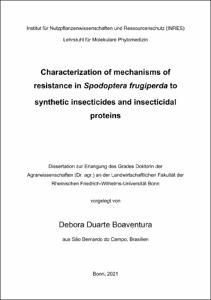Characterization of mechanisms of resistance in Spodoptera frugiperda to synthetic insecticides and insecticidal proteins

Characterization of mechanisms of resistance in Spodoptera frugiperda to synthetic insecticides and insecticidal proteins

| dc.contributor.advisor | Grundler, Florian M. W. | |
| dc.contributor.author | Duarte Boaventura, Debora | |
| dc.date.accessioned | 2021-03-18T14:40:45Z | |
| dc.date.available | 2021-03-18T14:40:45Z | |
| dc.date.issued | 18.03.2021 | |
| dc.identifier.uri | https://hdl.handle.net/20.500.11811/8993 | |
| dc.description.abstract | Fall armyworm (FAW), Spodoptera frugiperda(J.E. Smith), is a major lepidopteran pest of maize in the American continent butitis now present in 107 countries worldwide. The control of FAW has relied mainly on the use of synthetic insecticides and transgenic crops expressing Bacillus thuringiensis(Bt) insecticidal proteins. However, the effective control of this pest is challenging, as resistance to 41 different active substances has been reported worldwide, putting at risk the yield of important staple crops.
Diamides act on insect ryanodine receptors (RyR) and are the most modern insecticide class intensively used to control lepidopteran pests. A highlydiamide-resistant population of FAW from Brazil has been selected in the laboratory. Sequencing of the C-terminal end of the RyR revealed the presence of a conserved point mutation (I4790M) linked to diamide resistance. Resistance to Bt crops in Brazil has been reported since 2014. In this thesis, the molecular mechanism conferring Cry1F resistance in Brazilian FAW was investigated and characterized. Different mutations were observed in exon 14 of the Bt receptor ATP-Binding Cassette subfamily C2 (ABCC2) transporter. However, the deletion of glycine and tyrosine (GY deletion) was found in higher frequency in field-collected strains of FAWhighly resistant to Cry1F. Failures of FAW control with Bt crops and consequently high infestation pressure in the field require additional insecticide applications. Therefore, the toxicological profile of a Cry1F-resistant strain(Sf_Des)was also investigated to different commercial insecticides.Laboratory bioassays with 15 active substances revealed that Sf_Deshas a medium level of resistance to deltamethrin and chlorpyrifos in comparison to the Cry1F-susceptible strain. Very high cross-resistance was observed among Cry1 toxins, but high susceptibility against Vip3A. RNA-Seq data support a major role of P450 enzymes in the detoxification of insecticides and RT-qPCR analysis confirmed that CYP9A-like and CYP6B39are significantly up-regulated (>200-fold) in the Cry1F-resistant strain. Methods for the detection of target-site mutations were developed and used to genotype 34 FAW populations from different continents. The diagnostic methods revealed a high frequency of mutations in acetylcholinesterase, conferring resistance to organophosphates and carbamates. In voltage-gated sodium channels targeted by pyrethroids, only one population from Indonesia showed a mutation. No mutations were detected in the ryanodine receptor, suggesting susceptibility to diamides. Indels in the ABCC2 associated with Bt-resistance were observedin samples collected in Puerto Rico and Brazil. Additionally, we analyzed all samples for the presence of markers associated with two sympatric FAW host plant strains. The molecular methods established show robust results in FAW samples collected across a broad geographical range and can be used to support decisions for sustainable FAW control and applied resistance management. The data presented here characterized novel molecular mechanisms conferring resistance to different insecticides/Bt toxins which remained elusive yet. Those findings not only support further research on new insecticides compounds overcoming such resistance mechanisms, but also provide practical guidance for the regional implementation of efficient resistance management strategies. | en |
| dc.language.iso | eng | |
| dc.rights | In Copyright | |
| dc.rights.uri | http://rightsstatements.org/vocab/InC/1.0/ | |
| dc.subject.ddc | 580 Pflanzen (Botanik) | |
| dc.subject.ddc | 630 Landwirtschaft, Veterinärmedizin | |
| dc.title | Characterization of mechanisms of resistance in Spodoptera frugiperda to synthetic insecticides and insecticidal proteins | |
| dc.type | Dissertation oder Habilitation | |
| dc.publisher.name | Universitäts- und Landesbibliothek Bonn | |
| dc.publisher.location | Bonn | |
| dc.rights.accessRights | openAccess | |
| dc.identifier.urn | https://nbn-resolving.org/urn:nbn:de:hbz:5-61321 | |
| ulbbn.pubtype | Erstveröffentlichung | |
| ulbbnediss.affiliation.name | Rheinische Friedrich-Wilhelms-Universität Bonn | |
| ulbbnediss.affiliation.location | Bonn | |
| ulbbnediss.thesis.level | Dissertation | |
| ulbbnediss.dissID | 6132 | |
| ulbbnediss.date.accepted | 02.02.2021 | |
| ulbbnediss.institute | Landwirtschaftliche Fakultät : Institut für Nutzpflanzenwissenschaften und Ressourcenschutz (INRES) | |
| ulbbnediss.fakultaet | Landwirtschaftliche Fakultät | |
| dc.contributor.coReferee | Borgemeister, Christian |
Dateien zu dieser Ressource
Das Dokument erscheint in:
-
E-Dissertationen (1116)




